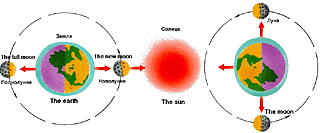Tides
About tides
Tidal oscillations are caused by the forces of gravitational attraction of the Moon and Sun, and the determining force is the gravitational attraction of the Moon. The top of a tidal wave appears to follow the Moon during its diurnal motion round the Earth. The greatest tidal ranges are observed in a syzygy (during a full Moon and a new Moon), when Moon and Sun are on one line with the Earth. When a quarter Moon (quadrature) occurs, the Earth is at the point of a right angle formed by the directions of the Moon and Sun, and the tidal range is the lowest. The highest water level during one period of tidal oscillations is called, 'high water', and the lowest, 'low water.' The tidal range is the difference between these levels.Simply put, a tide is a repeated cycle of sea level changes in the following stages:
- over several hours the water rises or advances up a beach in the flood;
- the water reaches its highest level, called high water;
- the sea level lowers or falls over several hours during the ebb tide
- the level stops falling at low water.
Characteristics of tides
The range and characteristics of tides in different regions of the world's oceans are variable. Apart from tidal ranges being affected by gravitational forces of the Moon and the Sun, the shape of the shoreline, bottom relief, depth, angle of approach of tidal waves to the coast and other local factors influence them. In the open ocean, tidal oscillations are insignificant, but on coasts they can be sizeable. For example, the greatest tidal range on Earth is in the Bay of Fundy (on east coast of North America in Canada), reaching 18m; in Penzhinskaya Guba of the Sea of Okhotsk it is 13m; on the northwest shores of Australia it is 11m and so on.
In the Atlantic Ocean, half-diurnal tides predominate, where a lunar day (24h 50m) regularly sees two high and two low waters. In the northern part of the Pacific and in Indian Ocean there are regions with diurnal tides -- that is, where within a lunar day, there are almost always one high and one low water. Tidal onsets are accompanied by tidal currents, the speed of which can reach coasts at several meters per second. The knowledge of tidal oscillations, ranges and currents is necessary for safety of navigation, nautical engineering, construction and for other kinds of economic activity. For this purpose, observations of time, range, height and the nature of tidal currents are routinely compiled as a 'tide tables' forecast.




